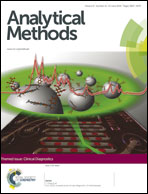A chemically modified electrode with hydroquinone derivative based on carbon nanoparticles for simultaneous determination of isoproterenol, uric acid, folic acid and tryptophan
Abstract
A nanostructure electrochemical sensor with a carbon paste electrode has been used to study the electrocatalytic oxidation of isoproterenol (IP) in the presence of uric acid, folic acid and tryptophan. In this work carbon nanoparticles (CNPs) and 7-(3,4-dihydroxyphenyl)-10,10-dimethyl-9,10,11,12-tetrahydrobenzo[c]acridin-9 (7H)-one (DDTA) were used for investigation of the electrochemical behaviour of IP. An apparent charge transfer rate constant of ks = 1.99 s−1, and transfer coefficient of α = 0.51, for the electron transfer between the modifier and the carbon paste electrode were calculated. In the optimum pH (pH = 9.0), the oxidation of IP at the modified electrode occurs at a potential about 298 mV less positive than the unmodified carbon paste electrode. The catalytic rate constant (k = 134.28 M−1 s−1) and diffusion coefficient (D = 3.7 × 10−5 cm2 s−1) were calculated for IP by chronoamperometry. Differential pulse voltammetry (DPV) exhibited two linear dynamic ranges of 0.25 to 20.0 μM and 20.0 to 2000.0 μM for IP. There was a decrease in sensitivity of the second linear segment due to kinetic limitations. Also, the modified electrode was used to determine IP in the presence of uric acid (UA), folic acid (FA) and tryptophan (TRY) by differential pulse voltammetry. Simultaneous determination of these four compounds was performed on the proposed sensor for the first time. This sensor was used for the determination of IP from an ampoule sample. The detection limit of the IP was calculated as 0.075 μM.


 Please wait while we load your content...
Please wait while we load your content...